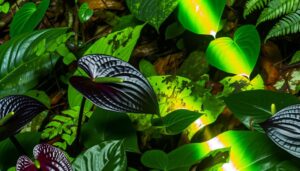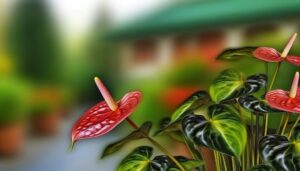Why Is Anthurium Red Heart Special? Key Benefits & Uses!
You’ll find the Anthurium Red Heart special due to its vivid red spathes and heart-shaped leaves, originating from the tropical rainforests of Central and South America. High anthocyanin concentrations give its spathes an intense red hue, enhancing UV protection and oxidative stress tolerance.
Its glossy leaves maximize photosynthetic efficiency and water retention, while the thick spadix hosts numerous minute flowers. Robust cellular structures maintain long-lasting blooms, and efficient metabolic processes guarantee prolonged vibrancy.
At home, it boosts air quality through phytoremediation, providing a calming atmosphere. To gain extensive insights into its care and benefits, continue exploring further.
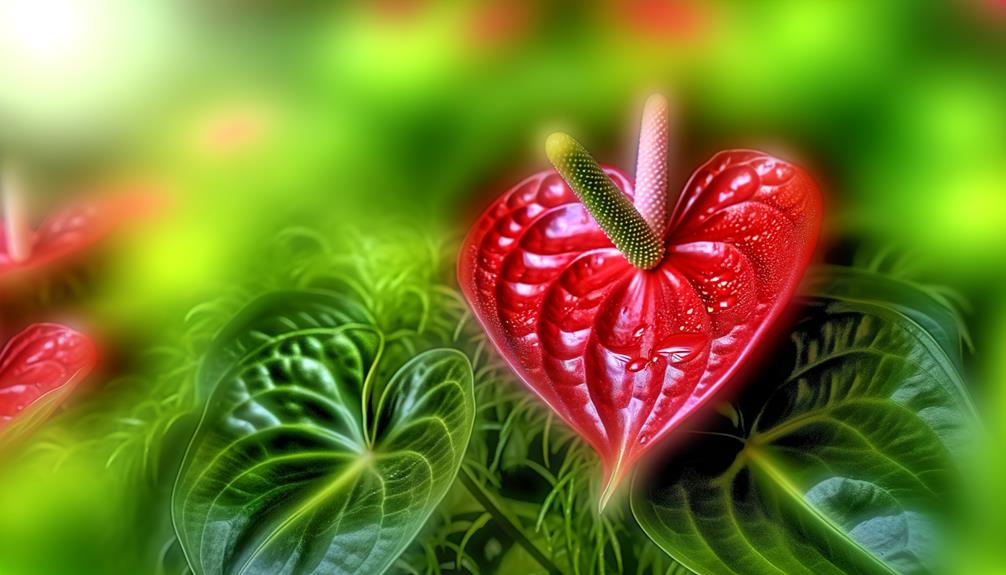
Key Takeaways
- Vivid red spathes and heart-shaped leaves create striking visual appeal.
- High anthocyanin concentration provides protection against UV radiation and oxidative stress.
- Efficiently filters indoor air toxins, improving air quality.
- Thrives in humid, shaded environments, making it resilient and easy to care for.
- Long-lasting blooms maintain their vibrant color and structure for extended periods.
Fascinating Origins
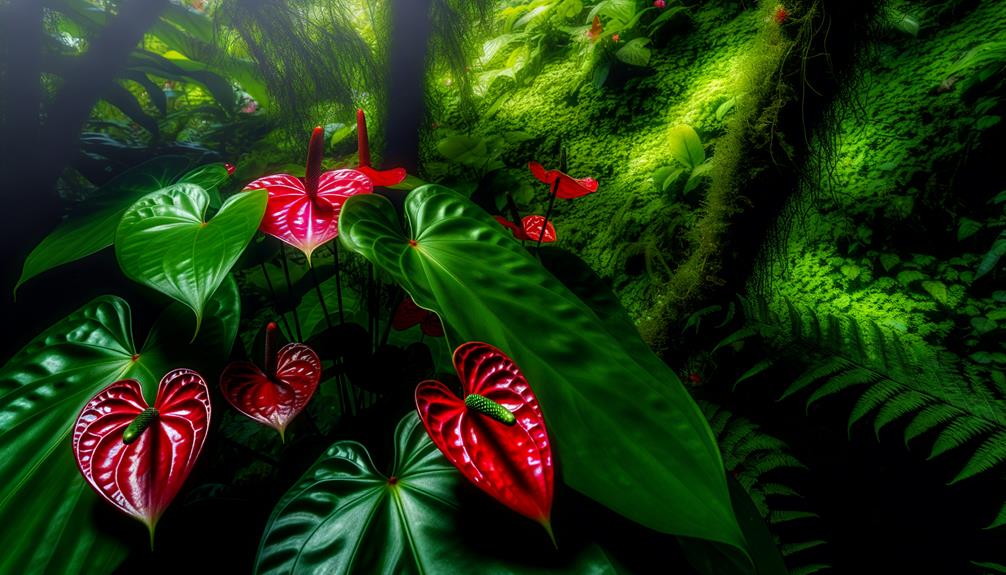
Anthurium Red Heart, known for its striking crimson spathes, originates from the tropical rainforests of Central and South America. You’ll find it thriving in the understory layer, where it benefits from the humid, shaded environment.
The plant’s roots are adapted to the nutrient-rich, well-drained soils typically found in these regions. Anthurium Red Heart exhibits epiphytic growth, often anchoring itself to trees, allowing it to access higher light levels while avoiding competition for ground space.
Its leaves are broad and glossy, designed to capture filtered sunlight efficiently. Understanding this origin helps you replicate these conditions for best growth in your indoor spaces. By mimicking its natural habitat, you’ll optimize your Anthurium Red Heart’s flourishing.
Unique Characteristics
Understanding its origins reveals several unique characteristics that make the Red Heart stand out, including its vivid red spathes and heart-shaped leaves designed for best light absorption and moisture retention.
The Anthurium Red Heart’s spathes display an intense red hue due to high anthocyanin concentration, enhancing its visual appeal. Its leaves, often exhibiting a glossy texture, are shaped to maximize photosynthetic efficiency and water retention, essential for its survival in native tropical environments.
The plant’s aroid structure includes a thick, fleshy spadix which houses minute flowers, optimizing reproductive success. Additionally, the cuticle layer on its leaves minimizes water loss, making it highly resilient.
These unique adaptations highlight the Red Heart’s evolutionary sophistication and aesthetic charm, perfect for any botanical enthusiast.
Long-Lasting Blooms
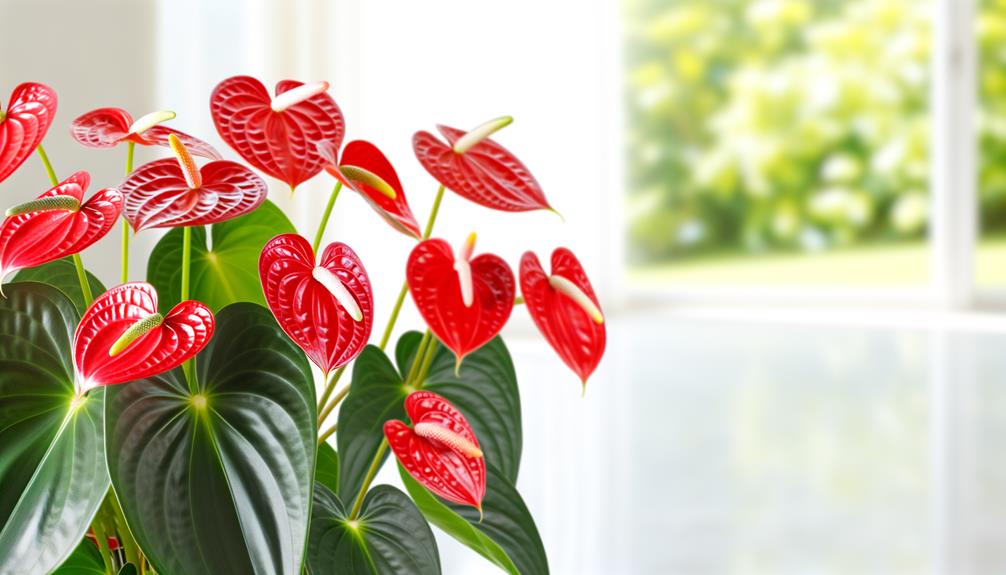
The Red Heart’s blooms, characterized by their vibrant red spathes, exhibit remarkable longevity due to their robust cellular structure and efficient metabolic processes.
You’ll appreciate how the spathes maintain their vivid coloration and structural integrity for weeks.
This endurance stems from the high concentration of anthocyanin pigments and a well-regulated water balance within the spathes’ cells.
These pigments not only provide striking colors but also protect against UV radiation and oxidative stress.
The plant’s metabolic efficiency ensures peak nutrient delivery and waste removal, extending bloom life. The spadix, adorned with tiny flowers, stays fresh, enhancing overall aesthetics.
You’ll find this combination of biological resilience and visual appeal makes the Red Heart truly extraordinary among flowering plants.
Easy Care Tips
Caring for your Red Heart Anthurium involves ensuring ideal light, humidity, and soil conditions to promote its vigorous growth and vibrant blooms.
Place your plant in bright, indirect light to prevent leaf scorching while encouraging photosynthesis. Maintain high humidity levels around 60-80% using a humidifier or pebble tray.
Water your Anthurium when the top inch of soil feels dry, ensuring proper drainage to avoid root rot.
Use a well-draining potting mix, such as a blend of orchid bark, peat moss, and perlite, to provide aeration and retain adequate moisture.
Fertilize bi-monthly with a balanced, diluted liquid fertilizer during the growing season to support nutrient uptake.
Home Environment Benefits
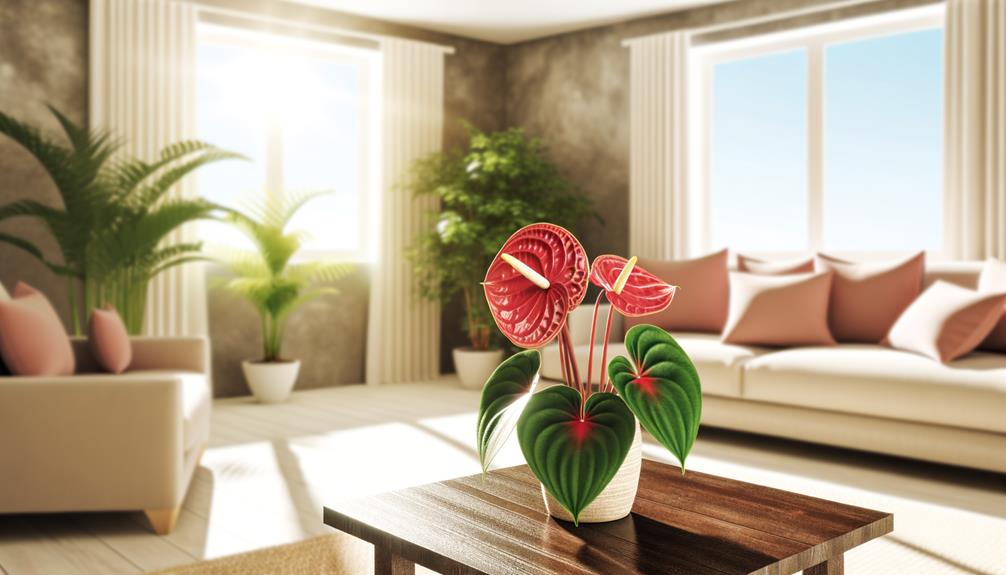
Incorporating an Anthurium Red Heart into your home environment enhances indoor air quality by effectively filtering toxins like formaldehyde, ammonia, and xylene. Its large, glossy leaves act as natural air purifiers, utilizing a process called phytoremediation.
This process involves the absorption and breakdown of harmful chemicals through the plant’s root system and leaves.
You’ll notice a marked improvement in the freshness of your indoor air, reducing respiratory irritants and promoting overall well-being.
Additionally, the Anthurium Red Heart maintains peak humidity levels by releasing moisture through transpiration, which helps combat dry indoor air.
Its vibrant red spathes not only add aesthetic appeal but also contribute to a calming atmosphere, enhancing both your physical and emotional health.
Conclusion
To sum up, you’ll find the Anthurium Red Heart to be a botanical treasure trove, blending fascinating origins with unique characteristics. Its long-lasting blooms are the crown jewels of any home, providing an unparalleled aesthetic.
Caring for this plant is straightforward, ensuring it thrives in your living space. Like a revitalizing breeze, it also enhances your home environment, improving air quality through natural processes.
Embrace the Anthurium Red Heart and enrich your indoor garden.

